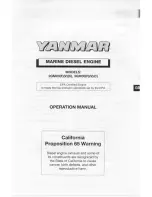
SYSTEMS AND SCHEDULED MAINTENANCE
25
Operator’s Manual Marine Diesel Engines
Revision 0. 05/2016
7.
After the valve clearance on the valves for all cylinders has been adjusted, turn the
crankshaft two or three times and make sure the valve clearance is correct.
Valve clearance should be inspected and adjusted when the engine is cold.
ADJUSTING
1.
Loosen the lock nut of the adjusting screw. Adjust
the clearance by turning the screw in either
direction to the extent that the gauge is slightly
gripped between the rocker arm and valve cap.
2.
After adjusting the clearance, tighten the lock nut.
Inspect the clearance again and make sure that it
is correct.
MAINTENANCE TASK. COMPRESSION PRESSURE INSPECTION
Start by:
1.
Make sure the engine oil level, air cleaner, starting
motor and battery are well-conditioned.
2.
Start the engine and allow it to warm up
thoroughly,
until
50ºC
or
more
coolant
temperature.
Measure the compression pressure on all cylinders:
1.
Remove the injection nozzle from the cylinder
head where the compression pressure is to be measured.
2.
Attach the compression pressure gauge.
3.
Disconnect the stop solenoid connector (the fuel supply shut off) and crank the engine
by means of the starter, and read the compression pressure gauge indication when the
engine is running at specified speed.
4.
If the compression pressure is lower than repair limit, check the engine parts affected.
Engine
speed
Compression
pressure
Repair limit
Máximum pressure difference
between cyilinders
SM-84 / SM-92
300 rpm
2,9 MPa
(30 kgf/cm
2
)
2,6 MPa
(27 kgf/cm
2
)
0,25 MPa
(2,5 kgf/cm
2
)
-
It is not a good practice to measure the compression pressure on only few cylinders,
and presume the compression on the remaining cylinders.
-
Compression pressure varies with engine speed. Check engine speed when
measuring the compression pressure.
-
The compression pressure will be slightly higher in a new or overhauled engine due to
new piston rings, valve seats, etc
















































